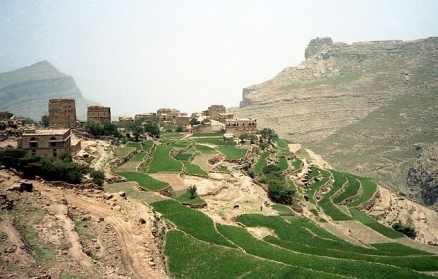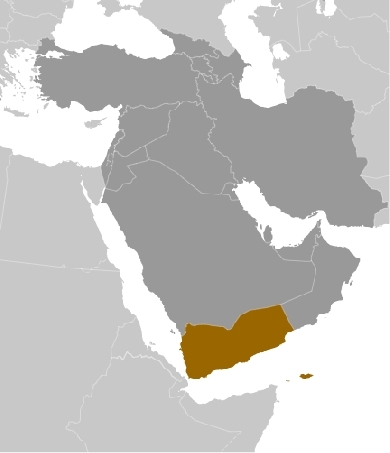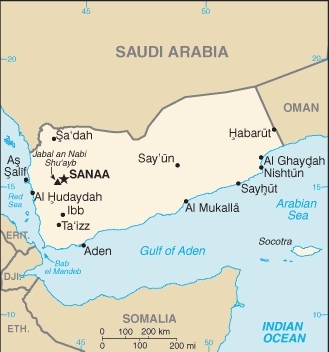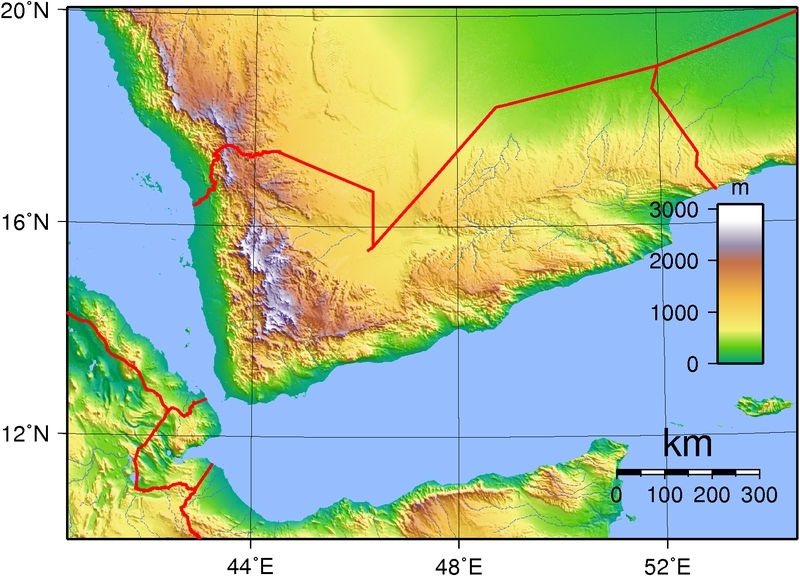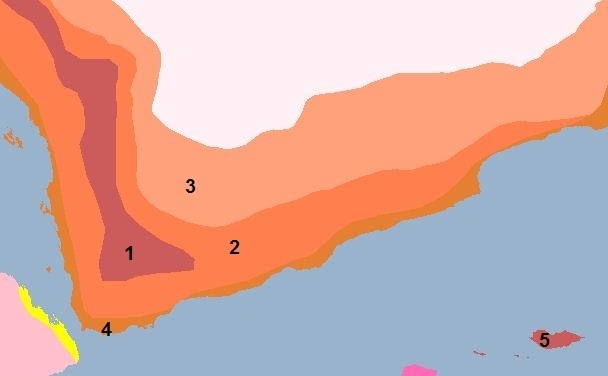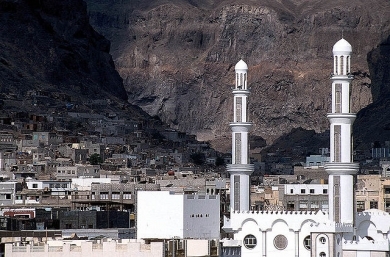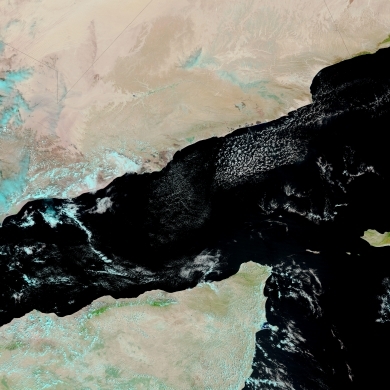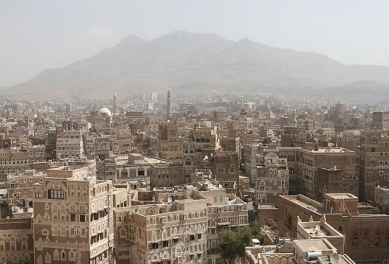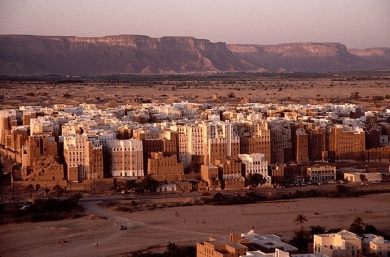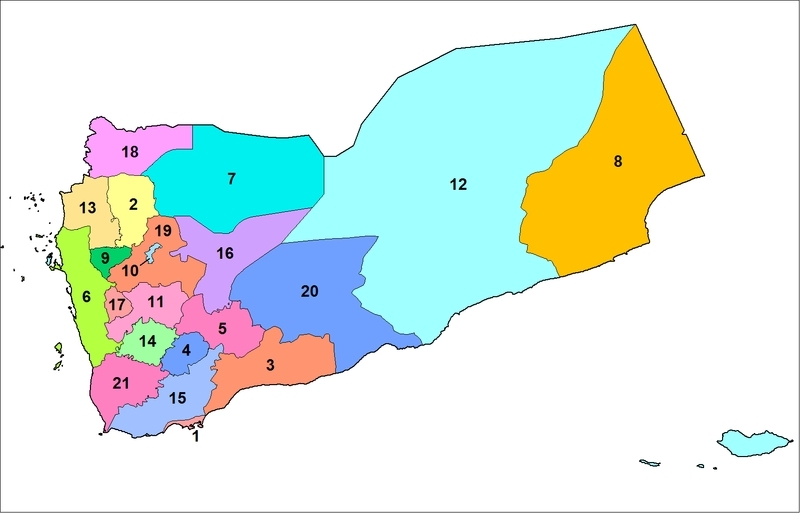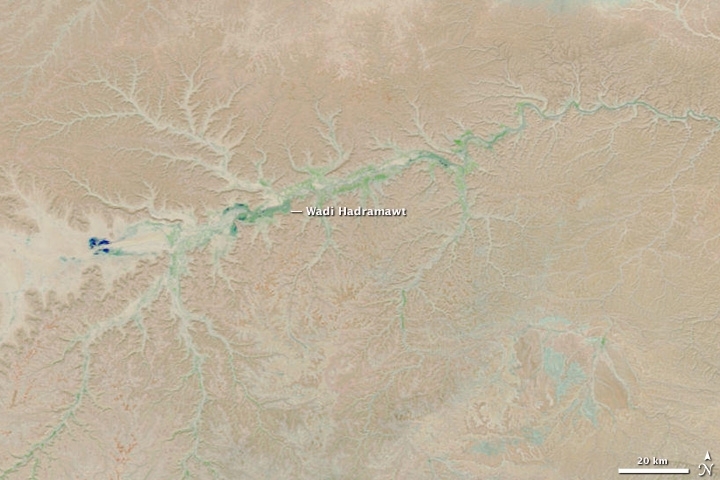Yemen
Countries and Regions of the World Collection  Yemen is a nation in the Middle East, bordering the Arabian Sea, Gulf of Aden, and Red Sea, between Oman and Saudi Arabia (Oman). It also includes Socotra, which includes four islands in the Indian Ocean, east of the Horn of Africa.
Yemen is a nation in the Middle East, bordering the Arabian Sea, Gulf of Aden, and Red Sea, between Oman and Saudi Arabia (Oman). It also includes Socotra, which includes four islands in the Indian Ocean, east of the Horn of Africa.
It has a strategic location on Bab el-Mandeb, the strait linking the Red Sea and the Gulf of Aden, one of world's most active shipping lanes.
Its major environmental issues include:
- limited natural freshwater resources;
- inadequate supplies of potable water;
- overgrazing;
- soil erosion; and,
- desertification
North Yemen became independent of the Ottoman Empire in 1918.
The British, who had set up a protectorate area around the southern port of Aden in the 19th century, withdrew in 1967 from what became South Yemen.
Three years later, the southern government adopted a Marxist orientation. The massive exodus of hundreds of thousands of Yemenis from the south to the north contributed to two decades of hostility between the states. The two countries were formally unified as the Republic of Yemen in 1990.
A southern secessionist movement in 1994 was quickly subdued.
In 2000, Saudi Arabia and Yemen agreed to a delimitation of their border. Saudi Arabia has reinforced its concrete-filled security barrier along sections of the fully demarcated border with Yemen to stem illegal cross-border activities.
Fighting in the northwest between the government and Huthi rebels, a group seeking a return to traditional Zaydi Islam, began in 2004 and has since resulted in six rounds of fighting - the last ended in early 2010 with a ceasefire that continues to hold.
The southern secessionist movement was revitalized in 2008 when a popular socioeconomic protest movement initiated the prior year took on political goals including secession.
Public rallies in Sana'a against President Salih - inspired by similar demonstrations in Tunisia and Egypt - slowly built momentum starting in late January 2011 fueled by complaints over high unemployment, poor economic conditions, and corruption. By the following month, some protests had resulted in violence, and the demonstrations had spread to other major cities. By March the opposition had hardened its demands and was unifying behind calls for Salih's immediate ouster.
The Gulf Cooperation Council (GCC) in late April 2011, in an attempt to mediate the crisis in Yemen, proposed an agreement in which the president would step down in exchange for immunity from prosecution. Salih's third refusal to sign the GCC agreement in late May led to heavy street fighting, and in early June an explosion at the mosque in the presidential compound injured Salih, who was evacuated to Saudi Arabia for treatment. June witnessed an increasing number of clashes with government and anti-government forces - some with links to al-Qa'ida in the Arabian Peninsula - in a number of cities and towns in southern Yemen.
In late September, Salih returned to Sanaa amid heavy shelling and machinegun fire between loyal regime forces and defector military forces. The UN Security Council passed Resolution 2014 in October calling on both sides to end the violence and complete a power transfer deal.
In late November 2011, President Salih signed the GCC-brokered agreement to step down and to transfer some of his powers to Vice President Abd al-Rabuh Mansur Hadi. Following elections in February 2012, won by Hadi, Salih formally transferred his powers.
Contents
Geography
Location: Middle East, bordering the Arabian Sea, Gulf of Aden, and Red Sea, between Oman and Saudi Arabia
Geographic Coordinates: 15 00 N, 48 00 E
Area: 527,968 sq km. Note: includes Perim, Socotra, the former Yemen Arab Republic (YAR or North Yemen), and the former People's Democratic Republic of Yemen (PDRY or South Yemen)
Land Boundaries: 1,746 km (Oman 288 km, Saudi Arabia 1,458 km)
Coastline: 1,906 km
Maritime Claims:
territorial sea: 12 nm
contiguous zone: 24 nm
exclusive economic zone: 200 nm
continental shelf: 200 nm or to the edge of the continental margin
Natural Hazards: sandstorms and dust storms in summer
Terrain: narrow coastal plain backed by flat-topped hills and rugged mountains; dissected upland desert plains in center slope into the desert interior of the Arabian Peninsula. The highest point is Jabal an Nabi Shu'ayb (3,760 m).
Climate: mostly desert; hot and humid along west coast; temperate in western mountains affected by seasonal monsoon; extraordinarily hot, dry, harsh desert in east
Topography of Yemen. Source: Wikimedia Commons.
Ecology and Biodiversity
Ecoregions of Yemen. Source: World Wildlife Fund.
- Southwestern Arabian montane woodlands coversthe southwestern Arabian highlands above 2,000 meters (m) and includes part of the Asir Mountains of Saudi Arabia and most of the western highlands of Yemen. In the west, a steep escarpment drops to the Tihamah plain on the Red Sea coast. To the east is a high plateau, with the mountains then sloping more gently to the inner desert regions and sands of the Rub’al-Khali (Empty Quarter). The escarpment mountains are the principal topographic feature here; they run in a north-south direction, parallel to and overlooking the Red Sea. The rugged mountainous landscape contains several peaks over 3,000 m, including Jebal Nabi Shu’ayb which, at 3,760 m, is the highest mountain in Yemen and all of the Arabian Peninsula. In Yemen, a tradition of high-mountain agriculture spanning two thousand years has produced a spectacular terraced landscape on the steep mountain slopes. However, this has eliminated much of the forest and woodland cover and only scattered patches of woodland now survive.
- Southwestern Arabian foothills savanna
- Red Sea Nubo-Sindian tropical desert and semi-desertpasses through the Mahara and northern Hadramaut Governates. The start of the Wadi Hadramaut, an area famous for its settled agriculture and ancient towns, is included.
- Arabian Peninsula coastal fog desertcovers much of the western and eastern coasts of the Arabian Peninsula. In Yemen, the region runs along more steep escarpments, followed by coastal plain as far as Aden and beyond. It then turns north to follow the Tihamah coastal plain to Jeddah in Saudi Arabia.
- Socotra Island xeric shrublands covers the Socotran Archipelago has such a unique assemblage of animal and plant species that it has been described as an Arabian Eden. The islands are best known for their plant diversity, including the dragon's blood tree and a variety of succulents. Approximately 30% of plants are endemic to the islands and ten genera are only found here. Reptilian fauna also demonstrates a high rate of endemism and a rich avifauna is found on the island. While currently relatively pristine, the ecoregion has had a long history of human occupation and over 50 endemic plants are listed on the IUCN Red List of Threatened Species. The Socotran Archipelago remains vulnerable to increased human activity and tourist and industrial development.
In Yemen, the main responsibility for wildlife conservation and environmental protection lies with the Environment Protection Council. As of 1994, there were no protected areas and little information exists on the current situation.
See also:
- Arabian Sea large marine ecosystem
- Red Sea large marine ecosystem
- Biological diversity in the Eastern Afromontane
|
In Yemen, an ancient harbor lies between an extinct volcano crater and the mainland. The natural harbor at Aden, which has been in use for 28 centuries, was made infamous in October 2000 when the U.S.S. Cole was bombed while moored there. Source: NASA. Credit: NASA GSFC Landsat/LDCM EPO Team |
| The old town of Aden, Yemen, situated in the crater of an extinct volcano. Source: Jialiang Gao/Wikimedia Commons. |
| Sana'a, Capital of Yemen. Ferdinand Reus/Wikimedia Commons |
| The high-rise architectures at Shibam, Wadi Hadhramaut (or Hadhramout, Hadramawt) Yemen. Source: Jialiang Gao/Wikimedia Commons. |
People and Society
Population: 24,771,809 (July 2011 est.)
Unlike other people of the Arabian Peninsula who have historically been nomads or semi-nomads, Yemenis are almost entirely settled and live in small villages and towns scattered throughout the highlands and coastal regions.
Yemenis are divided into two principal Islamic religious groups: the Shia Zaydi sect, found in the north and northwest, and the Shaf’i school of Sunni Muslims, found in the south and southeast. Yemenis are mainly of Semitic origin, although African strains are present among inhabitants of the coastal region. Arabic is the official language, although English is increasingly understood in major cities. In the Mahra area (the extreme east), several non-Arabic languages are spoken. When the former states of north and south Yemen were established, most resident minority groups departed.
Ethnic Groups: predominantly Arab; but also Afro-Arab, South Asians, Europeans
Age Structure:
0-14 years: 43% (male 5,285,218/female 5,094,736)
15-64 years: 54.4% (male 6,666,600/female 6,459,414)
65 years and over: 2.6% (male 298,175/female 329,349) (2011 est.)
Population Growth Rate: 2.575% (2011 est.)
Birthrate: 32.57 births/1,000 population (2011 est.)
Death Rate: 6.82 deaths/1,000 population (July 2011 est.)
Net Migration Rate: 0 migrant(s)/1,000 population (2011 est.)
Life Expectancy at Birth: 64.11 years
male: 62.05 years
female: 66.27 years (2011 est.)
Total Fertility Rate: 4.45 children born/woman (2011 est.)
Languages: Arabic (official)
Literacy (age 15 and over can read and write):
total population: 50.2%
male: 70.5%
female: 30% (2003 est.)
Urbanization: 32% of total population (2010) growing at an annual rate of change of 4.6% (2010-15 est.)
History
Yemen was one of the oldest centers of civilization in the Near East. Between the 12th century BC and the 6th century AD, it was part of the Minaean, Sabaean, and Himyarite kingdoms, which controlled the lucrative spice trade, and later came under Ethiopian and Persian rule. In the 7th century, Islamic caliphs began to exert control over the area. After this caliphate broke up, the former north Yemen came under control of Imams of various dynasties usually of the Zaydi sect, who established a theocratic political structure that survived until modern times. (Imam is a religious term. The Shi’ites apply it to the prophet Muhammad's son-in-law Ali, his sons Hassan and Hussein, and subsequent lineal descendants, whom they consider to have been divinely ordained unclassified successors of the prophet.)
Egyptian Sunni caliphs occupied much of north Yemen throughout the 11th century. By the 16th century and again in the 19th century, north Yemen was part of the Ottoman Empire, and in some periods its Imams exerted control over south Yemen.
Former North Yemen
Ottoman control was largely confined to cities with the Imam's suzerainty over tribal areas formally recognized. Turkish forces withdrew in 1918, and Imam Yahya Muhammad Hamid al-Din--who had established himself as the preeminent force in the northern highlands--strengthened his control over north Yemen. Yemen became a member of the Arab league in 1945 and the United Nations in 1947.
Imam Yahya died during an unsuccessful coup attempt in 1948. His son Ahmad succeeded him and ruled until his death in September 1962. Imam Ahmad's reign was marked by growing repression, renewed friction with the United Kingdom over the British presence in the south, and growing pressures to support the Arab nationalist objectives of Egyptian President Gamal Abdul Nasser.
Ahmad's son, Muhammad, assumed power in 1962. Revolutionary forces deposed him soon thereafter as they took control of Sanaa and created the Yemen Arab Republic (Y.A.R.). Egypt assisted the Y.A.R. with troops and supplies to combat forces loyal to the Imamate. Saudi Arabia and Jordan supported Muhammad's royalist forces to oppose the newly formed republic. Conflict continued periodically until 1967 when Egypt withdrew its troops. By 1968, following a final royalist siege of Sanaa, most of the opposing leaders reconciled; Saudi Arabia recognized the Republic in 1970.
Former South Yemen
After British forces captured the port of Aden in 1839, their influence increased in the south and eastern portion of Yemen. The United Kingdom ruled Aden as part of British India until 1937, when London made the port a crown colony with the remaining land designated as east Aden and west Aden protectorates. By 1965, most of the tribal states within the protectorates and the Aden colony proper had joined to form the British-sponsored federation of south Arabia.
In 1965, two rival nationalist groups--the Front for the Liberation of Occupied South Yemen (FLOSY) and the National Liberation Front (NLF)--turned to terrorism in their struggle to control the country. In 1967, in the face of uncontrollable violence, British troops began withdrawing, federation rule collapsed, and NLF elements took control after eliminating their FLOSY rivals. South Arabia, including Aden, declared independence on November 30, 1967, and renamed itself the People's Republic of South Yemen. In June 1969, a radical wing of the Marxist NLF gained power and changed the country's name on December 1, 1970, to the People's Democratic Republic of Yemen (P.D.R.Y.). In the P.D.R.Y., the government amalgamated all political parties into the Yemeni Socialist Party (YSP), which became the only legal party. The P.D.R.Y. established close ties with the Soviet Union, China, Cuba, and radical Palestinians.
Republic of Yemen
In 1972, the governments of the P.D.R.Y. and the Y.A.R. declared that they approved a future union. However, they made little progress toward unification, and relations were often strained. In 1979, simmering tensions led to fighting, which was only resolved after Arab League mediation. The northern and southern heads of state reaffirmed the goal of unity during a March 1979 summit meeting in Kuwait. However, that same year the P.D.R.Y. began sponsoring an insurgency against the Y.A.R. In April 1980, P.D.R.Y. President Abdul Fattah Ismail resigned and went into exile. His successor, Ali Nasir Muhammad, took a less interventionist stance toward both the Y.A.R. and neighboring Oman. On January 13, 1986, a violent struggle began in Aden between Ali Nasir Muhammad and the returned Abdul Fattah Ismail and his supporters. Fighting lasted for more than a month and resulted in thousands of casualties, Ali Nasir's ouster, and Ismail's death. Some 60,000 persons, including Ali Nasir and his supporters, fled to the Y.A.R.
In May 1988, the Y.A.R. and P.D.R.Y. governments came to an understanding that considerably reduced tensions including agreement to renew discussions concerning unification, establish a joint oil exploration area along their undefined border, demilitarize the border, and allow Yemenis unrestricted border passage on the basis of only a national identification card.
In November 1989, the leaders of the Y.A.R. (Ali Abdullah Saleh) and the P.D.R.Y. (Ali Salim Al-Bidh) agreed on a draft unity constitution that they had originally drawn up in 1981. The Republic of Yemen (R.O.Y.) was declared on May 22, 1990. Ali Abdullah Saleh became President, and Ali Salim Al-Bidh became Vice President.
The leaders set a 30-month transitional period for completing the unification of the two political and economic systems. The 26-member Y.A.R. advisory council and the 17-member P.D.R.Y. presidium jointly elected a presidential council. The presidential council appointed a Prime Minister, who formed a Cabinet. There was also a 301-seat provisional unified Parliament, consisting of 159 members from the north, 111 members from the south, and 31 independent members appointed by the chairman of the council.
The leaders agreed upon a unity constitution in May 1990, which the citizens ratified in a May 1991 popular referendum. The constitution affirmed Yemen's commitment to free elections, a multiparty political system, the right to own private property, equality under the law, and respect of basic human rights. Parliamentary elections were held on April 27, 1993. International groups assisted in the organization of the elections and observed actual balloting. The resulting Parliament included 143 GPC, 69 YSP, 63 Islah (Yemeni Grouping for Reform, a party composed of various tribal and religious groups). The head of Islah, paramount sheikh of the powerful Hashid tribal confederation Abdullah Bin Hussein Al-Ahmar, was elected speaker of Parliament. He served in that capacity until his death in 2007.
Islah was invited into the ruling coalition, and the presidential council was altered to include one Islah member. Conflicts within the coalition resulted in the self-imposed exile of Vice President Ali Salim Al-Bidh to Aden beginning in August 1993 and a deterioration in the general security situation as political rivals settled scores and tribal elements took advantage of the situation.
Haydar Abu Bakr Al-Attas (former southern Prime Minister) continued to serve as the R.O.Y. Prime Minister, but his government was ineffective due to political infighting. Continuous negotiations between northern and southern leaders resulted in the signing of the document of pledge and accord in Amman, Jordan on February 20, 1994. Despite this, clashes intensified until civil war broke out in early May 1994.
Almost all of the actual fighting in the 1994 civil war occurred in the southern part of the country despite air and missile attacks against cities and major installations in the north. Southerners sought support from neighboring states and received billions of dollars of equipment and financial assistance. The United States strongly supported Yemeni unity, but repeatedly called for a cease-fire and a return to the negotiating table. Various attempts, including by a UN special envoy, were unsuccessful in bringing about a cease-fire.
Southern leaders declared secession and the establishment of the Democratic Republic of Yemen (D.R.Y.) on May 21, 1994, but the D.R.Y. was not recognized by the international community. Ali Nasir Muhammad supporters greatly assisted military operations against the secessionists, and northern troops captured Aden on July 7, 1994. Other resistance quickly collapsed and thousands of southern political and military leaders went into exile. Early during the fighting, President Ali Abdullah Saleh announced a general amnesty, which applied to everyone except a list of 16 persons. Most southerners returned to Yemen after a short exile.
An armed opposition was announced from Saudi Arabia, but no significant incidents within Yemen materialized. The government prepared legal cases against four southern leaders--Ali Salim Al- Bidh, Haydar Abu Bakr Al-Attas, Abd Al-Rahman Ali Al-Jifri, and Salih Munassar Al-Siyali--for misappropriation of official funds. Abd Al-Rahman Ali Al-Rahman was allowed to return to Yemen in 2006. Others on the list of 16 were told informally they could return to take advantage of the amnesty, but most remained outside Yemen. Although many of Ali Nasir Muhammad's followers were appointed to senior governmental positions (including Vice President, Chief of Staff, and Governor of Aden), Ali Nasir Muhammad himself remained abroad in Syria.
In the aftermath of the civil war, YSP leaders within Yemen reorganized the party and elected a new politburo in July 1994. However, the party remained disheartened and lacked its former influence.
In 1994, amendments to the unity constitution eliminated the presidential council. On October 1, 1994, Parliament elected President Ali Abdullah Saleh to a 5-year term. In April 1997, Yemen held its second multiparty parliamentary elections. The country held its first direct presidential elections in September 1999, electing President Ali Abdullah Saleh to a 5-year term in what were generally considered credible elections.
Constitutional amendments adopted in the summer of 2000 extended the presidential term by 2 years, creating a 7-year presidential term. The amendments provided that henceforth the president would be elected by popular vote from at least two candidates selected by the legislature. The amendments also extended the parliamentary term of office to a 6-year term. On February 20, 2001, a new constitutional amendment created a bicameral legislature consisting of a Shura Council (111 seats; members appointed by the president) and a House of Representatives (301 seats; members elected by popular vote).
In April 2003, the third multiparty parliamentary elections were held with improvements in voter registration for both men and women. Two women were elected. The General People's Congress (GPC) maintained an absolute majority. International observers judged elections to be generally free and fair, and there was a marked decrease from previous years in election-related violence; however, there were some problems with underage voting, confiscation of ballot boxes, voter intimidation, and election-related violence.
In September 2006, citizens re-elected President Saleh to a second term in a generally open and competitive election, although there were multiple problems with the voting process and use of state resources on behalf of the ruling party. In the September 2006 local council elections, the GPC won a majority of seats on local and provincial councils. International observers judged the elections to be generally open and competitive, with another marked decrease in election-related violence.
Scheduled April 2009 parliamentary elections were postponed until 2011 by a parliamentary vote extending the members’ term in office to 8 years, but elections were not held in 2011 due to civil unrest.
Public rallies in Sana'a against President Salih - inspired by similar demonstrations in Tunisia and Egypt - slowly built momentum starting in late January 2011 fueled by complaints over high unemployment, poor economic conditions, and corruption. By the following month, some protests had resulted in violence, and the demonstrations had spread to other major cities. By March the opposition had hardened its demands and was unifying behind calls for Salih's immediate ouster.
The Gulf Cooperation Council (GCC) in late April 2011, in an attempt to mediate the crisis in Yemen, proposed an agreement in which the president would step down in exchange for immunity from prosecution. Salih's third refusal to sign the GCC agreement in late May led to heavy street fighting, and in early June an explosion at the mosque in the presidential compound injured Salih, who was evacuated to Saudi Arabia for treatment. June witnessed an increasing number of clashes with government and anti-government forces - some with links to al-Qa'ida in the Arabian Peninsula - in a number of cities and towns in southern Yemen.
In late September, Salih returned to Sanaa amid heavy shelling and machinegun fire between loyal regime forces and defector military forces. The UN Security Council passed Resolution 2014 in October calling on both sides to end the violence and complete a power transfer deal.
In late November 2011, President Salih signed the GCC-brokered agreement to step down and to transfer some of his powers to Vice President Abd al-Rabuh Mansur Hadi. Following elections in February 2012, won by Hadi, Salih formally transferred his powers.
Government
Government Type: republic
Yemen is a republic with a bicameral legislature. Under the constitution, an elected president, an elected 301-seat House of Representatives, and an appointed 111-member Shura Council share power. The president is head of state, and the prime minister is head of government. The constitution provides that the president be elected by popular vote from at least two candidates endorsed by Parliament; the prime minister is appointed by the president. The presidential term of office is 7 years, and the parliamentary term of elected office is 8 years. Suffrage is universal over 18.
In February 2011, Yemeni citizens began protesting against corruption and eventually for the ouster of President Ali Abdullah Saleh’s regime. Protests soon turned violent, prompting many to leave the ruling party for the opposition. International pressure on the Saleh regime intensified as evidenced by the passage of United Nations Human Rights Council and Security Council resolutions. The Gulf Cooperation Council (GCC) initiated a mechanism to transfer power from President Saleh. On November 23, 2011 after 8 months of deliberation, President Saleh signed the initiative beginning the transfer of power to a new government. As part of the implementation of the GCC initiative, Vice President Abdo Rabbo Mansour Hadi named a new cabinet to form a National Consensus Government in addition to a Military and Security Committee. The National Consensus Government will set the government mandate until 2014, and the Military and Security Committee is charged with de-escalating the tenuous security situation throughout Yemen. The next presidential elections had been scheduled for 2013, although the 2011 demonstrations accelerated the timeline to February 2012.
A presidential election was held on February 21, 2012 in accordance with the political transition initiative. President Abdo Rabbo Mansour Hadi was sworn in on February 25, 2012.
The constitution calls for an independent judiciary. The former northern and southern legal codes have been unified. The legal system includes separate commercial courts and a Supreme Court based in Sanaa.
Capital: Sanaa - 2.229 million (2009)
Administrative divisions: 21 governorates (muhafazat, singular - muhafazah);
|
|
|
|
Source: Mediawiki Commons
Independence Date: 22 May 1990 (Republic of Yemen was established with the merger of the Yemen Arab Republic (Sanaa) or North and the Marxist-dominated People's Democratic Republic of Yemen (Aden) or South).
Note - previously North Yemen became independent in November 1918 (from the Ottoman Empire) and became a republic with the overthrow of the theocratic Imamate in 1962; South Yemen became independent on 30 November 1967 (from the UK)
Legal System: mixed legal system of Islamic law, English common law, and customary law. Yemen has not submitted an International Court of Justice (ICJ) jurisdiction declaration; and is a non-party state to the International criminal court (ICCt).
International Environmental Agreements
Yemen is party to international agreements on: Biodiversity, Climate Change, Climate Change-Kyoto Protocol, Desertification, Endangered Species, Environmental Modification, Hazardous Wastes, Law of the Sea, and Ozone Layer Protection.
Water
Total Renewable Water Resources: 4.1 cu km (1997)
Freshwater Withdrawal: 6.63 cu km/yr (4% domestic, 1% industrial, 95% agricultural)
Per Capita Freshwater Withdrawal: 316 cu m/yr (2000)
Access to improved sources of drinking water: 62% of population
Access to improved sanitation facilities: 52% of population
See: Water profile of Yemen and Aquifer depletion
Widespread flooding swept over eastern Yemen after Tropical Storm Three drenched the country with heavy rains on October 24-25, 2008. The floods left 180 dead and displaced 20,000, said the World Health Organization. The floods destroyed homes, and damaged water, phone, and power networks.
This infrared-enhanced image shows flooding along the Wadi Hadramawt and the waterways that flow into it. The most severe flood damage was in cities along this important wadi. In the lower image, taken a little more than a week before the storm hit, the only sign of water is the faint hint of green vegetation along the Wadi Hadramawt. Water is blue in this type of image, so the green is likely sparse vegetation.
By October 30, top, pools of blue marked the Wadi Hadramawt. The traces of turquoise that line the wadi are probably water-soaked sand or mud. The landscape around the wadi resembles veins in a leaf, with large tributaries and tiny channels branching off the main channel of the wadi. This pattern suggests that although Yemen receives little rain, water has played a significant role in shaping the land.
The Moderate Resolution Imaging Spectroradiometer (MODIS) on NASA’s Terra satellite captured both images above and below. Source: NASA. Credit: NASA images courtesy the MODIS Rapid Response Team at NASA GSFC. Caption by Holli Riebeek.
Agriculture
Agricultural products: grain, fruits, vegetables, pulses, qat, coffee, cotton; dairy products, livestock (sheep, goats, cattle, camels), poultry; fish
Irrigated Land: 6,800 sq km (2008)
Resources
Natural Resources: petroleum, fish, rock salt, marble; small deposits of coal, gold, lead, nickel, and copper; fertile soil in west
Land Use:
arable land: 2.91%
permanent crops: 0.25%
other: 96.84% (2005)
Economy
Yemen is a low income country that is highly dependent on declining oil resources for revenue. Petroleum accounts for roughly 25% of GDP and 70% of government revenue.
At unification, both the Y.A.R. and the P.D.R.Y. were struggling, underdeveloped economies. In the north, disruptions of civil war (1962-70) and frequent periods of drought had dealt severe blows to a previously prosperous agricultural sector. Coffee production, formerly the north's main export and principal form of foreign exchange, declined as the cultivation of qat increased. Low domestic industrial output and a lack of raw materials made the Y.A.R. dependent on a wide variety of imports.
Remittances from Yemenis working abroad and foreign aid paid for perennial trade deficits. Substantial Yemeni communities exist in many countries of the world, including Yemen's immediate neighbors on the Arabian Peninsula, Indonesia, India, East Africa, the United Kingdom, and the United States. Beginning in the mid-1950s, the Soviet Union and China provided large-scale assistance to the Y.A.R. This aid included funding of substantial construction projects, scholarships, and considerable military assistance.
In the south, pre-independence economic activity was overwhelmingly concentrated in the port city of Aden. The seaborne transit trade, which the port relied upon, collapsed with the closure of the Suez Canal and Britain's withdrawal from Aden in 1967. Only extensive Soviet aid, remittances from south Yemenis working abroad, and revenues from the Aden refinery (built in the 1950s) kept the P.D.R.Y.'s centrally planned Marxist economy afloat. With the dissolution of the Soviet Union and a cessation of Soviet aid, the south's economy basically collapsed.
Since unification, the government has worked to integrate two relatively disparate economic systems. However, severe shocks, including the return in 1990 of approximately 850,000 Yemenis from the Gulf states, a subsequent major reduction of aid flows, and internal political disputes culminating in the 1994 civil war hampered economic growth.
After the conclusion of the war, the government entered into agreement with the International Monetary Fund (IMF) to institute a structural adjustment program. This IMF program included major financial and monetary reforms, including floating the currency, reducing the budget deficit, and cutting subsidies. Difficulties implementing the reform program led the agreement to lapse. In August 2010, a new IMF program was implemented under which Yemen received an Extended Credit Facility worth approximately $370 million that would be disbursed over 3 years. In order to receive the funds, Yemen agreed to implement various economic reforms in the areas of revenue diversification/tax system reform, subsidy reductions, and governmental spending. Due to political instability, the program was suspended in 2011. The IMF is working with the new Yemeni Government in order to assess program needs in the country.
The World Bank is present in Yemen as well, with many projects in the areas of public sector governance, water, employment, and education. Many World Bank projects were interrupted during 2011 due to the political crisis. The World Bank is working with the Yemeni Government, the IMF, and international donors on efforts to resume project activity in Yemen. Since 1998, the government of Yemen has sought to implement World Bank economic and fiscal recommendations.
Yemen also receives significant bilateral foreign aid for development projects and humanitarian needs. Germany, Japan, Saudi Arabia, and the United Arab Emirates are among Yemen’s largest bilateral donors. In 2006, Yemen received $4.7 billion in foreign aid pledges during a donor conference in London. Much of the pledged support remains undisbursed due to difficulties absorbing the aid. The U.K. in 2010 organized a ministerial-level Friends of Yemen meeting after a failed terrorist attempt on the U.S. originated from Yemen. The Friends of Yemen included the G-8, Gulf Cooperation Council states, European Union members, multilateral donor organizations, and other key partners of Yemen to form two working groups on “Economy and Governance” and “Justice and Rule of Law”. The Friends of Yemen aimed to support Yemen’s efforts to address its challenges and make recommendations on reforms that would help develop and strengthen the country. The Friends of Yemen process stalled in 2011 when the political unrest began. Given the establishment of the National Consensus Government in December 2011 and the presidential election in February 2012, efforts to move forward with priorities identified at the Friends of Yemen ministerial have resumed.
While Yemen is a relatively minor oil producer when compared to its Gulf neighbors, energy exports generate the majority of governmental revenue. Production peaked in 2001 at approximately 440,000 barrels per day (bbl/d) and has declined since. In 2010, the country produced, on average, approximately 260,000 bbl/d. Following a minor discovery in southern Yemen in 1982, an American company found an oil basin near Marib in 1984, and a small oil refinery began operations 2 years later. A Soviet discovery in the southern governorate of Shabwa proved only marginally successful. A Western consortium began exporting oil from Masila in Hadramaut governorate in 1993, and production there reached 420,000 bbl/d in 1999. There are new finds in the Jannah (formerly known as the Joint Oil Exploration Area) and east Shabwah blocks.
In November 2005, Hunt Oil’s 20-year contract for the management of Block 18 fields ended. Despite agreement with the Government of Yemen on a 5-year extension, the government abrogated the agreement via a parliamentary vote that was not called for in the contract. The U.S.-based Hunt Oil company sued Yemen in a Paris-based International Chamber of Commerce commercial arbitration court in 2005. The court’s decision has been kept confidential, according to both sides’ wishes. Hunt Oil continues to operate in Yemen, although in a much smaller oil exploration block. In December 2011, Yemen also ended its production sharing agreement in Block 14 with the Canadian firm Nexen. The Yemeni Government made a decision not to renew its contract with Nexen in favor of a newly formed, Yemeni Government-controlled company, PetroMasila.
Yemen's oil exports in 1995 generated approximately $1 billion in revenues. By 2010, oil exports had grown to approximately $5.5 billion and comprised roughly 70% of governmental revenue. Crude oil production has declined steadily in past years due to dwindling reserves, lack of maintenance on some equipment, and a lack of new investment in exploration activities.
Oil located near Marib contains associated natural gas. Yemen’s natural gas reserves are currently being exported in the form of liquefied natural gas (LNG), and projects are underway that utilize Yemen’s LNG to fuel several natural gas-fired power plants. The Yemen LNG project at the port of Balhaf on the Gulf of Aden became commercially operational in October 2009 and will generate much needed revenue to partially offset declining oil revenues.
Yemen has tried to counter the effects of its declining oil resources by diversifying its economy through an economic reform program initiated in 2006 that is designed to bolster non-oil sectors of the economy and foreign investment. In October 2009, Yemen exported its first liquefied natural gas as part of this diversification effort.
In January 2010, the international community established the Friends of Yemen group that aims to support Yemen's efforts towards economic and political reform, and in August 2010 the IMF approved a three-year $370 million program to further this effort.
Despite these ambitious endeavors, Yemen continues to face difficult long term challenges, including declining water resources and a high population growth rate.
GDP: (Purchasing Power Parity):$63.24 billion (2011 est.)
GDP: (Official Exchange Rate): $36.7 billion (2011 est.)
GDP- per capita (PPP): $2,500 (2011 est.)
GDP- composition by sector:
agriculture: 7.9%
industry: 42.2%
services: 49.9% (2011 est.)
Industries: crude oil production and petroleum refining; small-scale production of cotton textiles and leather goods; food processing; handicrafts; small aluminum products factory; cement; commercial ship repair; natural gas production
Currency: Yemeni rials (YER)
See: Energy profile of Yemen
